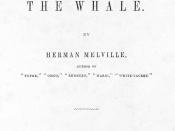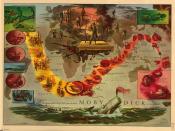Herman Melville's novel, Moby Dick, may on the surface seem to be the story of a sea captain obsessed with a whale. More than that, however, Moby Dick is an account of humankind's struggle against an uncontrollable and sometimes violent natural world. In the chapter entitled The Quarter Deck the reader is given a glimpse into Captain Ahab's madness, and the opportunity to see that madness reflected, not only from his crew, but from the whole of the human race.
Through Ishmael's narrative we see the image of Ahab's ship, the Pequod, as a metaphorical earth: with people of all manner of race and creed (albeit all male and all sailors). For example, Ishmael uses a metaphor describing Ahab's morning walk along the ship's deck, "planks so familiar to [Ahab's] tread, that they were all over dented like geological stones, with the peculiar mark of his walk. Did you fixedly gaze, too, upon that ribbed and dented brow; there also, you would see still stranger foot-prints--the foot-prints of his one unsleeping, ever-pacing thought" (2312).
Not only is the ship the earth, but Ahab becomes the ship, and his "thought," his obsession, is captain.
Later, as Starbuck begins to question Ahab's motives in his vendetta against the whale, suggesting the futility of "vengeance on a dumb brute," Ahab urges his mate to consider "the little lower layer," telling Starbuck that:
All visible objects, man, are but as pasteboard masks. But in each event--in the living act, the undoubted deed--there, some unknown but still reasoning thing puts forth the mouldings of its features from behind the unreasoning mask. If man will strike, strike through the mask! How can the prisoner reach outside except by thrusting through the wall? To me, the white whale is that wall, shoved near to me....he...


